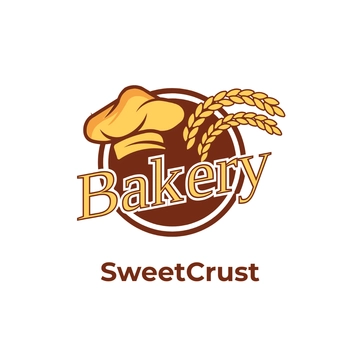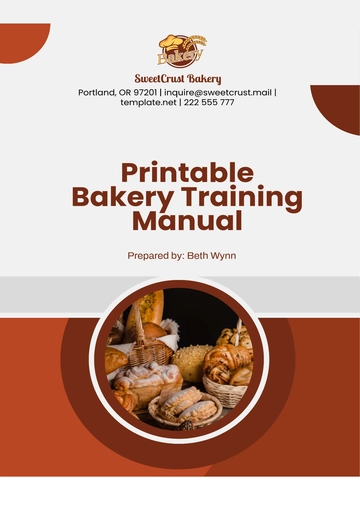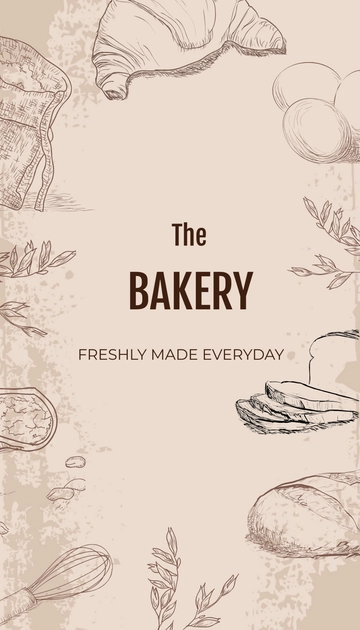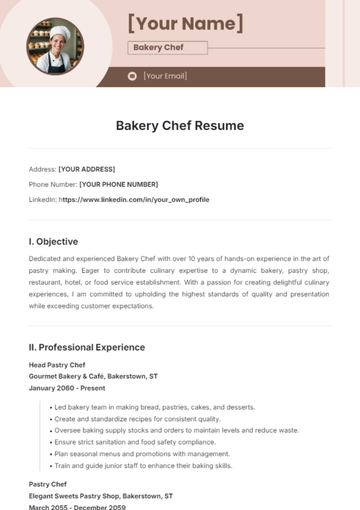Free Bakery Guideline

I. Introduction
Welcome to the [Your Company Name] Bakery Guideline. This comprehensive document is designed to provide clear and concise instructions to ensure the smooth operation of our bakery. Whether you're a new employee or a seasoned staff member, this guideline will help you understand our standards, processes, and expectations. At [Your Company Name], we take pride in delivering high-quality baked goods and exceptional customer service. By adhering to these guidelines, we can maintain the excellence our customers have come to expect.
Our commitment to quality, safety, and customer satisfaction is at the core of everything we do. This guideline covers essential aspects of our bakery operations, including food safety standards, hygiene practices, ingredient handling, baking processes, and customer service protocols. We have aligned our practices with US laws and industry standards to ensure compliance and promote a safe and efficient work environment. We encourage all team members to familiarize themselves with this document and reach out to their supervisors with any questions or concerns. Together, we can continue to create delicious products and memorable experiences for our customers.
II. Setting Up the Bakery
Setting up the bakery each day is crucial for ensuring a smooth and efficient operation. This section outlines the steps and procedures to prepare the bakery for a successful day of baking and customer service.
A. Opening Procedures
Opening procedures are essential to get the bakery ready for the day. This includes arriving early, turning on equipment, ensuring cleanliness, and maintaining high hygiene standards to create a safe and efficient working environment.
Arrival and Preparation | Sanitization |
|---|---|
|
|
B. Stocking Ingredients and Supplies
Proper stocking of ingredients and supplies is vital for uninterrupted operations. Regular inventory checks and ingredient preparation help maintain quality and efficiency in baking, ensuring the bakery runs smoothly.
Inventory Check | Ingredient Preparation |
|---|---|
|
|
C. Equipment Check and Maintenance
Regular equipment checks and maintenance are essential for efficient baking operations. This includes preheating ovens, inspecting mixers, and ensuring refrigeration units are functioning correctly to prevent any disruptions.
Ovens and Mixers | Refrigeration Units |
|---|---|
|
|
D. Display and Merchandising
Effective display and merchandising attract customers and boost sales. Arranging products attractively, updating signage, and rotating stock ensure freshness and enhance the bakery's appeal to customers.
Product Placement | Signage and Promotions |
|---|---|
|
|
By following these procedures, the bakery will be well-prepared to start the day efficiently and effectively, ensuring a smooth workflow and an inviting atmosphere for customers.
III. Bakery Operations
Bakery operations encompass a variety of tasks that must be managed efficiently to ensure consistent product quality and customer satisfaction. This section details the day-to-day activities necessary for running a successful bakery.
A. Baking Schedule
The baking schedule is the backbone of bakery operations. It involves planning and timing the production of various baked goods to meet customer demand throughout the day. This covers the steps to create and maintain an effective baking schedule.
Plan production for various baked goods: Allocate specific times for baking bread, pastries, cakes, and specialty items.
Consider preparation, baking, and cooling times: Ensure products are fresh and available when needed.
Adjust schedule based on demand: Use past sales data to predict peak times and adjust the baking schedule accordingly.
Coordinate with staff: Ensure all bakers and kitchen staff are aware of the schedule and their roles.
B. Quality Control
Maintaining high-quality standards is essential for any bakery. Quality control involves monitoring the consistency of ingredients, the accuracy of measurements, and the precision of baking times and temperatures. Here's the outline of the procedures for ensuring product quality.
Monitor consistency of ingredients: Ensure all ingredients meet the bakery's quality standards.
Check accuracy of measurements: Use precise measurements for all recipes.
Control baking times and temperatures: Follow exact baking times and temperatures for each product.
Regularly taste products: Conduct taste tests to ensure quality and consistency.
Inspect for visual appeal: Check the appearance of baked goods to ensure they meet presentation standards.
Adhere to food safety regulations: Maintain sanitary conditions to prevent contamination and spoilage.
C. Customer Service
Customer service plays a significant role in the overall success of the bakery. Employees must be trained to provide friendly, efficient, and knowledgeable service. Below is the list of the key aspects of excellent customer service.
Provide friendly greetings: Ensure all customers feel welcome when they enter the bakery.
Answer questions about products: Train staff to be knowledgeable about ingredients, allergens, and product details.
Handle transactions quickly and accurately: Ensure efficient and accurate payment processing.
Encourage customer feedback: Solicit and use feedback to improve products and service.
Create a welcoming environment: Maintain a clean and inviting atmosphere in the bakery.
D. Inventory Management
Efficient inventory management ensures that the bakery has the necessary ingredients and supplies to operate without interruption. Listed below are the steps involved in managing inventory effectively.
Track inventory levels: Regularly check stock levels of all ingredients and supplies.
Place orders with suppliers: Order ingredients and supplies in a timely manner to avoid shortages.
Manage deliveries: Ensure timely and accurate receipt of ordered items.
Properly store ingredients: Store ingredients in appropriate conditions to maintain freshness.
Rotate inventory: Use older stock first to minimize waste and spoilage.
E. Waste Management
Managing waste is an important aspect of bakery operations. Efforts should be made to minimize waste by accurately predicting demand and adjusting production levels accordingly. Below, we outline the waste management practices.
Predict demand accurately: Use sales data to forecast demand and adjust production.
Repurpose leftovers: Find creative ways to use leftover products.
Donate excess products: Donate unsold items to local charities or food banks.
Implement recycling programs: Recycle packaging materials and other recyclable items.
Compost organic waste: Set up a composting program for organic waste such as food scraps.
Effective bakery operations require careful planning, attention to detail, and a commitment to quality and customer satisfaction. By managing the baking schedule, maintaining high standards, providing excellent customer service, efficiently handling inventory, and minimizing waste, a bakery can ensure smooth operations and continued success.
IV. Customer Service
Exceptional customer service is vital for building a loyal customer base and enhancing the overall bakery experience. This section outlines the key aspects of providing outstanding service in a bakery setting.
A. Customer Interaction
The way employees interact with customers sets the tone for their experience at the bakery. Staff should be trained to offer warm, friendly greetings to every customer upon entry. Engaging customers with a genuine smile and offering assistance with product choices helps create a welcoming atmosphere. Staff should be attentive and responsive to customer inquiries about ingredients, allergens, and product details, ensuring that they provide accurate and helpful information. Listening carefully to customer needs and preferences helps tailor the service to each individual, enhancing satisfaction.
B. Handling Transactions
Efficient and accurate handling of transactions is essential for a smooth customer experience. Employees should be well-trained in operating the point-of-sale system to ensure quick and accurate processing of payments. Providing clear explanations of prices and any applicable promotions or discounts helps avoid confusion and build trust with customers. Ensuring that receipts are provided upon request and handling cash or card transactions with care and confidentiality further contributes to a positive customer experience.
C. Resolving Complaints
Addressing and resolving customer complaints effectively is crucial for maintaining a positive reputation. Staff should be trained to listen to complaints with empathy and without defensiveness. Acknowledging the issue, apologizing for any inconvenience, and taking prompt action to resolve the problem are essential steps. Offering solutions, such as refunds or replacements, demonstrates a commitment to customer satisfaction. Following up with the customer to ensure the issue has been resolved to their satisfaction can help restore confidence and loyalty.
D. Creating a Positive Atmosphere
Creating a positive atmosphere in the bakery involves maintaining a clean and inviting environment. Staff should ensure that the bakery is tidy and well-organized, with products attractively displayed. Ambient factors such as pleasant music, pleasant aromas, and comfortable seating areas contribute to a positive overall experience. Encouraging a friendly and cooperative team dynamic among staff helps ensure that customers receive consistently high-quality service.
Exceptional customer service in a bakery is achieved through effective interaction, efficient transaction handling, prompt complaint resolution, and a welcoming atmosphere. These elements collectively contribute to a memorable and satisfying experience for customers.
V. Marketing Strategies
Effective marketing strategies are crucial for driving business growth and attracting new customers to your bakery. By implementing a variety of marketing techniques, bakeries can enhance their visibility, build brand loyalty, and increase sales. The goal is to create a comprehensive approach that includes both traditional and digital methods, ensuring that marketing efforts reach a wide audience and engage customers in meaningful ways.
The table below outlines essential marketing strategies tailored for a bakery setting. Each strategy is designed to help bakeries effectively promote their products and connect with their target market.
Marketing Strategy | Description |
|---|---|
Promotional Campaigns | Develop targeted campaigns to highlight special offers, new products, or seasonal items. These can include discounts, buy-one-get-one-free offers, or limited-time specials. |
Social Media Engagement | Utilize platforms such as Instagram, Facebook, and Twitter to share updates, showcase products, and engage with followers. Post regularly and interact with customer comments. |
Local Partnerships | Partner with other local businesses, such as coffee shops or event venues, to cross-promote products and reach new customer segments. Consider joint events or co-branded promotions. |
Community Events | Participate in or sponsor local events like farmers' markets, festivals, or charity functions. This increases visibility and connects with the local community. |
Loyalty Programs | Implement a rewards program to encourage repeat business. Offer incentives such as discounts, free items, or exclusive offers to customers who frequently visit or purchase. |
Email Marketing | Send regular newsletters featuring new products, special offers, and bakery news to subscribers. Personalize emails based on customer preferences and past purchases. |
VI. Financial Management
Effective financial management is the cornerstone of a successful bakery. Proper handling of finances ensures that the bakery operates smoothly, remains profitable, and can invest in future growth. From budgeting and cost control to financial reporting and cash flow management, each aspect plays a crucial role in maintaining the bakery’s financial health.
The following table details key financial management practices essential for bakery operations.
Financial Practice | Description |
|---|---|
Budgeting | Create a detailed budget that includes projected revenues, expenses, and capital investments. Review and adjust regularly. |
Expense Tracking | Monitor and record all business expenses, including ingredients, utilities, and labor costs. Keep receipts and invoices. |
Revenue Management | Track sales and revenue streams, analyze sales data to identify trends, and adjust pricing or promotions accordingly. |
Cash Flow Management | Monitor the flow of cash in and out of the business to ensure sufficient liquidity for operations and unforeseen expenses. |
Financial Reporting | Generate regular financial reports, such as profit and loss statements and balance sheets, to assess business performance. |
Tax Compliance | Ensure timely and accurate filing of tax returns, and keep records of all tax-related transactions and documents. |
VII. Conclusion
A well-structured bakery operation requires careful planning and execution across multiple areas, from daily setup and customer service to effective marketing and financial management. Each aspect, whether it’s ensuring that ingredients are fresh, customer interactions are positive, or marketing strategies are innovative, plays a crucial role in the bakery’s overall success. By adhering to these guidelines, bakeries can create a welcoming environment, attract and retain customers, and maintain financial stability.
Maintaining a focus on quality, efficiency, and customer satisfaction will help in building a strong reputation and achieving long-term success. Continuous evaluation and adjustment of practices based on performance and feedback ensure that the bakery remains competitive and adaptable in a dynamic market. Implementing these strategies effectively will pave the way for a thriving bakery business that consistently meets and exceeds customer expectations.
- 100% Customizable, free editor
- Access 1 Million+ Templates, photo’s & graphics
- Download or share as a template
- Click and replace photos, graphics, text, backgrounds
- Resize, crop, AI write & more
- Access advanced editor
Establish clear protocols with the Bakery Guideline Template from Template.net. Fully customizable and editable, this template provides comprehensive instructions for all bakery operations. Editable in our AI Editor Tool, it ensures your guidelines are professional, detailed, and tailored to your bakery’s specific needs.





























